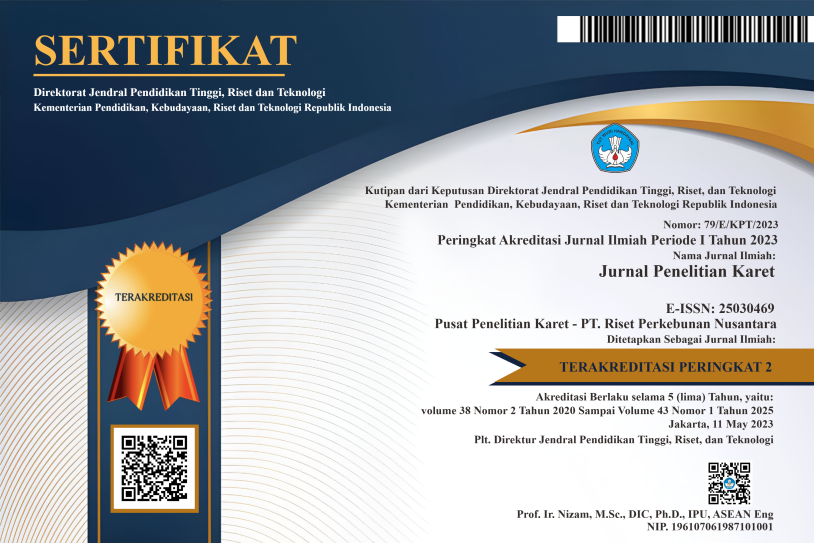KARAKTERISASI ISOLAT PESTALOTIOPSIS PADA KARET (Hevea brasiliensis) MENGGUNAKAN KARAKTER MORFOLOGI DAN MOLEKULER
DOI:
https://doi.org/10.22302/ppk.jpk.v39i2.798Keywords:
karet, molekuler, morfologi, penyakit gugur daun, PestalotiopsisAbstract
Penyakit gugur daun Pestalotiopsis yang disebabkan oleh Pestalotiopsis sp. pada tanaman karet telah menjadi penyakit yang merugikan sejak tahun 2017 di pertanaman karet Indonesia. Hampir semua klon rekomendasi dan semua stadia tanaman karet terserang penyakit yang mengakibatkan penurunan produksi lateks. Informasi patogen mengenai karakter morfologi dan molekuler diperlukan untuk mengetahui siklus hidup dan biologi patogen tersebut. Penelitian ini bertujuan mendeteksi spesies Pestalotiopsis yang menyerang tanaman karet di wilayah Sumatra Selatan secara morfologi dan molekuler. Sampel daun yang terinfeksi penyakit gugur daun diambil dari Kebun Percobaan Pusat Penelitian Karet, Desa Lalang Sembawa, Kabupaten Banyuasin, Sumatra Selatan. Penelitian dilaksanakan di Laboratorium Proteksi Pusat Penelitian Karet dan Laboratorium Mikologi dan Biomolekuler Karantina Tumbuhan, Balai Besar Uji Standar Karantina Pertanian (BBUSKP), Jakarta pada bulan April hingga Desember 2019. Metode pada penelitian ini diawali pengambilan sampel dari beberapa tanaman inang yang bergejala, kemudian dilakukan isolasi pada media PDA, dimurnikan, kemudian dilakukan identifikasi morfologi pada masing-masing isolat, selanjutnya dilakukan analisa PCR dan hasil PCR yang terpilih dilanjutkan dengan sequencing. Hasi penelitian ini menunjukkan morfologi Pestalotiopsis dibedakan berdasarkan bentuk konidia, ukuran konidia, jumlah septat, warna pigmen, serta bentuk sel basal dan sel tengah. Spesies Pestalotiopsis yang diperoleh berdasarkan pengamatan morfologi yaitu P. microspore, P. linearis, P. quepinii, P. kunmingensis, P clavate, dan P. cocos. Hasil amplifikasi cendawan daun karet ini diperoleh 7 jenis isolat yang memiliki ukuran pita DNA yang berbeda, dan diperoleh 2 jenis cendawan gugur daun dari hasil sequensing yaitu Pseudopestalotiopsis coccos strain CBS 272,29 dan Neopestalotiopsis cubana strain CBS 600,96.
References
Febbiyanti, T. R. (2019). Severe outbreak of Pestalotiopsis leaf disease in South Sumatra. Disampaikan pada MRB-IRRDB Workshop, Melaka, Malaysia, 9th-10th April 2019.
Febbiyanti, T. R., & Fairuza, Z. (2019). Identifikasi penyebab kejadian luar biasa penyakit gugur daun karet di Indonesia. Jurnal Penelitian Karet, 37(2): 193-206. DOI: 10.22302/ppk.jpk.v37i2.616
Jeewon, R., Liew, E. C. Y., & Hydea, K. D. (2002). Phylogenetic relationships of Pestalotiopsis and allied genera inferred from ribosomal DNA sequences and morphological characters. Molecular Phylogenetics and Evolution, 25(3):378-392. Doi: 10.1016/S1055-7903(02)00422-0.
Karakaya, A. (2001). First report of infection of kiwifruit by Pestalotiopsis sp. in Turkey. Plant Disease, 85:1028.
Keith, L. M., Maile, E. V., & Francis, T. Z. (2006). Identification and characterization of Pestalotiopsis spp. causing scab disease of guava, Psidium guajava, in Hawaii. Plant Disease, 90(1):16-23.
Kimaru, S. K., Monda, I. E., Cheruiyot, R. C., Mbaka, & Alakonya, A. (2018). Morphological and molecular identification of the causal agentof anthracnose disease of avocado in Kenya. International Journal of Microbiology, (4):1-10. DOI: 10.1155/2018/4568520
Kusdiana, A. P. J., Sinaga, M. S., & Tondok, E. T. (2020). Diagnosis penyebab penyakit gugur daun baru (Hevea brasiliensis Muell. Arg.). Jurnal Penelitian Karet, 38(20): 165-178. doi: https://doi.org/10.22302/ppk.jpk.v2i38.728.
Legiastuti, T. S., & Aminingsih, T. (2012). Identifikasi jamur endofit menggunakan teknik Polymerase Chain Reaction. Jurnal Fitopatologi Indonesia, 8(2): 31-32.
Liu, A. R., Chen, S. C., lin, X. M., Wu, S. Y., Xu., T., Cai, F. M., & Jeewon, R. (2010). Endopytic Pestalotiopsis species associated with plants of palmae, Rhizophoraceae, Planchonellae and Podocarpaceae in Hainan, China. African J. of Microb. Res., 4(24): 2661-2669.
Liu, F., Hou, L., & Cai, L. (2017). Pestalotiopsis and allied genera from Camellia, with description of 11 new species from China. Sci. Rep., 7(1):866. Doi: 10.1038/s41598-017-00972-5.
Maharachchikumbara, S. S. N., Hyde, K. D., Groenewald, J. X, & Crous, P. W. (2014) Pestalotiopsis revisited. Studies in Mycology, 79:121-186.
Maharachchikumbura, S. S. N., Guo, L. D., Liu, Z. Y., Liu, & Hyde, K. D. (2016). Pseudopestalotiopsis ignota and Ps. camelliae spp. nov. associated with grey blight disease of tea in China. Mycology Progress, 15(22).
Maharachchikumbura, S. S. N., Rignon, P., Hyde K. D., Al Sadi, A. M., & Liu, Z. Y. (2016). Characterization of Neopestalotiopsis, Pestalotiopsis and Truncatella species associated with grapevine trunk diseases in France. Phytopathologia Mediterranea, 55(3): 380−390.
Meli, C. D., & Langer, E. (2009). Pestalotiopsis theae (Ascomycota, Amphisphaeriaceae) on seeds of Diospyros crassiflora (Ebenaceae). Mycotaxon.107: 441-448.
Norphanphoun, C., Jayawardena, R. S., Chen, Y., Wen, T. C., Meepol, W., & Hyde, K. D. (2019). Morphological and phylogenetic characterization of novel Pestalotioid species associated with mangroves in Thailand. Mycosphere, 10(1): 531–578.
Shamly, V., Kali, A., Srirangaraj, S., & Umadevi, S. (2014). Comparison of microscopic morphology of fungi using lactophenol cotton blue (lpcb), iodine glycerol and congo red formaldehyde staining. J. Clin. Diagn. Res., 8(7). Doi: 10.7860/JCDR/2014/8521.4535
Silva, A. C., Diogo, E., Henriques J., Ramos A. P., Sandoval-Denis, M., Crus, P. W., & Bragança, H. (2020). Pestalotiopsis pini sp. nov., an emerging pathogen on stone pine (Pinus pinea L.). Forests, 11(805): 1-17. Doi:10.3390/f11080805.
Solarte, F., Munoz, C. G., Maharachchikumbura, S. S. N., & Alvarez, E. (2018). Diversity of Neopestalotiopsis and Pestalotiopsis spp., causal agents of guava scab in Colombia. Plant Disease, 102: 49-59.
Suwannarach, N., Sujarit, K., & Lumyong, S. (2013). First report of leaf spot disease on oil palm caused by Pestalotiopsis theae in Thailand. J. of General Plant Path. 79: 277-279.
Tamura, K., Dudley, J., Nei, M., & Kumar, S. (2007). MEGA4: molecular evolutionary genetics analysis (MEGA) software version 4.0. Molecular Biology and Evolution, 24(8): 1596-1599.
White, T. J., Bruns, T. D., Lee, S. B., & Taylor, J. W. (1990). Amplification and direct sequencing of fungal RNA genes for phylogenetics. In M. A. Innis & D. H. Gelfand (Ed.). PCR Protocols, a Guide to Methods and Applications (pp. 315-322).
Downloads
Published
How to Cite
Issue
Section
License
Copyright (c) 2022 Tri Rapani Febbiyanti, Radite Tistama, Yudiarto Sarsono

This work is licensed under a Creative Commons Attribution-ShareAlike 4.0 International License.
Submission of a original research article in Jurnal Penelitian Karet implies that the submitted  manuscript has not been published in any scientific journal (except being part of the abstract, thesis, or report). The submitted manuscript also is not under consideration for publication elsewhere. All co-authors involve in the publication of the manuscript should give their approval.
Once, the manuscript is accepted and then published in Jurnal penelitian Karet, the Author(s) keep hold the copyright and retain publishing right without restrictions.
Author(s) and Jurnal Penelitian Karet users are allowed to multiply the published manuscript. The journal users are also permissible to share the published manuscript with an acknowledgement to the Author(s). The Editorial Boards suggest that the Authors should manage patent before publishing their new inventions.
















